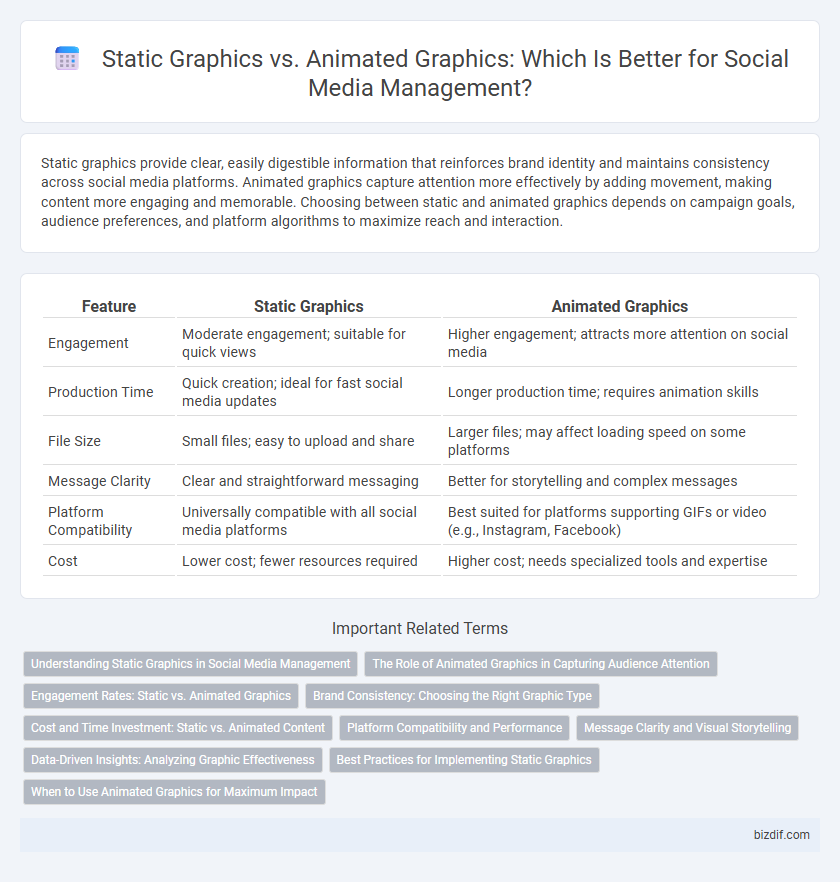Static graphics provide clear, easily digestible information that reinforces brand identity and maintains consistency across social media platforms. Animated graphics capture attention more effectively by adding movement, making content more engaging and memorable. Choosing between static and animated graphics depends on campaign goals, audience preferences, and platform algorithms to maximize reach and interaction.
Table of Comparison
| Feature | Static Graphics | Animated Graphics |
|---|---|---|
| Engagement | Moderate engagement; suitable for quick views | Higher engagement; attracts more attention on social media |
| Production Time | Quick creation; ideal for fast social media updates | Longer production time; requires animation skills |
| File Size | Small files; easy to upload and share | Larger files; may affect loading speed on some platforms |
| Message Clarity | Clear and straightforward messaging | Better for storytelling and complex messages |
| Platform Compatibility | Universally compatible with all social media platforms | Best suited for platforms supporting GIFs or video (e.g., Instagram, Facebook) |
| Cost | Lower cost; fewer resources required | Higher cost; needs specialized tools and expertise |
Understanding Static Graphics in Social Media Management
Static graphics in social media management involve non-moving images such as photos, illustrations, or infographics that effectively convey clear, concise messages. These visuals are easy to create, share, and load quickly, enhancing audience engagement and brand consistency across platforms like Instagram, Facebook, and LinkedIn. Brands leverage static graphics to reinforce messaging, improve visual identity, and support content strategies with high-quality, impactful visuals.
The Role of Animated Graphics in Capturing Audience Attention
Animated graphics significantly enhance audience engagement by adding motion and interactivity, making social media content more eye-catching and memorable. Unlike static graphics, animations can convey complex messages quickly, increasing the likelihood of capturing viewers' attention in fast-scrolling feeds. Platforms like Instagram and Facebook prioritize video and animated content, boosting reach and interaction rates through dynamic visuals.
Engagement Rates: Static vs. Animated Graphics
Animated graphics on social media platforms typically generate higher engagement rates compared to static graphics, with studies showing up to a 40% increase in likes, shares, and comments. Users are more likely to interact with dynamic content due to its eye-catching movement and storytelling potential. Brands leveraging animated visuals benefit from enhanced user attention and prolonged content interaction, driving stronger audience connections.
Brand Consistency: Choosing the Right Graphic Type
Static graphics offer a clear and consistent visual identity, reinforcing brand colors, logos, and typography without distraction, which helps maintain strong brand recognition. Animated graphics can enhance engagement by adding movement and storytelling elements, but if overused or inconsistent, they risk diluting brand identity. Selecting the right graphic type depends on balancing brand consistency with audience interaction goals, ensuring every visual element aligns with the overall brand strategy.
Cost and Time Investment: Static vs. Animated Content
Static graphics require less time and lower production costs due to simpler design processes and fewer technical resources compared to animated graphics. Animated content demands a higher investment in specialized software, skilled animators, and longer development cycles, which can significantly increase both budget and time commitments. Brands must weigh the balance between cost-efficiency and engagement potential when choosing between static and animated graphics for social media campaigns.
Platform Compatibility and Performance
Static graphics offer broad platform compatibility and faster loading times, making them ideal for social media platforms with strict file size limits such as Instagram and Twitter. Animated graphics enhance engagement through motion but can suffer from reduced performance due to larger file sizes and potential platform restrictions, particularly on mobile devices with slower connections. Optimizing animated content through compression and format selection like GIF or MP4 ensures better performance without sacrificing visual appeal across diverse social media environments.
Message Clarity and Visual Storytelling
Static graphics offer clear and concise message delivery, making key information easily digestible for social media audiences. Animated graphics enhance visual storytelling by capturing attention and conveying complex narratives through motion and dynamic elements. Choosing between static and animated visuals depends on the desired balance between straightforward communication and engaging, immersive content.
Data-Driven Insights: Analyzing Graphic Effectiveness
Analyzing data from social media campaigns reveals that animated graphics typically generate up to 30% higher engagement rates compared to static graphics, driven by increased viewer attention and interaction. Metrics such as click-through rates, shares, and time spent on posts highlight the superior performance of animated content in boosting brand visibility and user retention. However, static graphics still perform effectively in delivering clear, concise messages, especially in platforms or ads where simplicity and quick consumption are prioritized.
Best Practices for Implementing Static Graphics
Static graphics in social media management should prioritize clarity, brand consistency, and visual appeal to maximize engagement and message retention. Use high-resolution images, maintain a cohesive color palette aligned with brand identity, and incorporate clear, concise text overlays to enhance communication effectiveness. Optimizing file sizes ensures faster loading times without sacrificing quality, improving user experience across multiple devices and platforms.
When to Use Animated Graphics for Maximum Impact
Animated graphics are ideal for capturing attention in crowded social media feeds by conveying complex messages quickly and engagingly. They enhance brand storytelling during product launches, tutorials, or announcements, boosting viewer retention and interaction rates. Use animations when aiming to increase click-through rates and social shares, as dynamic content consistently outperforms static images in algorithm-driven visibility.
static graphics vs animated graphics Infographic

 bizdif.com
bizdif.com